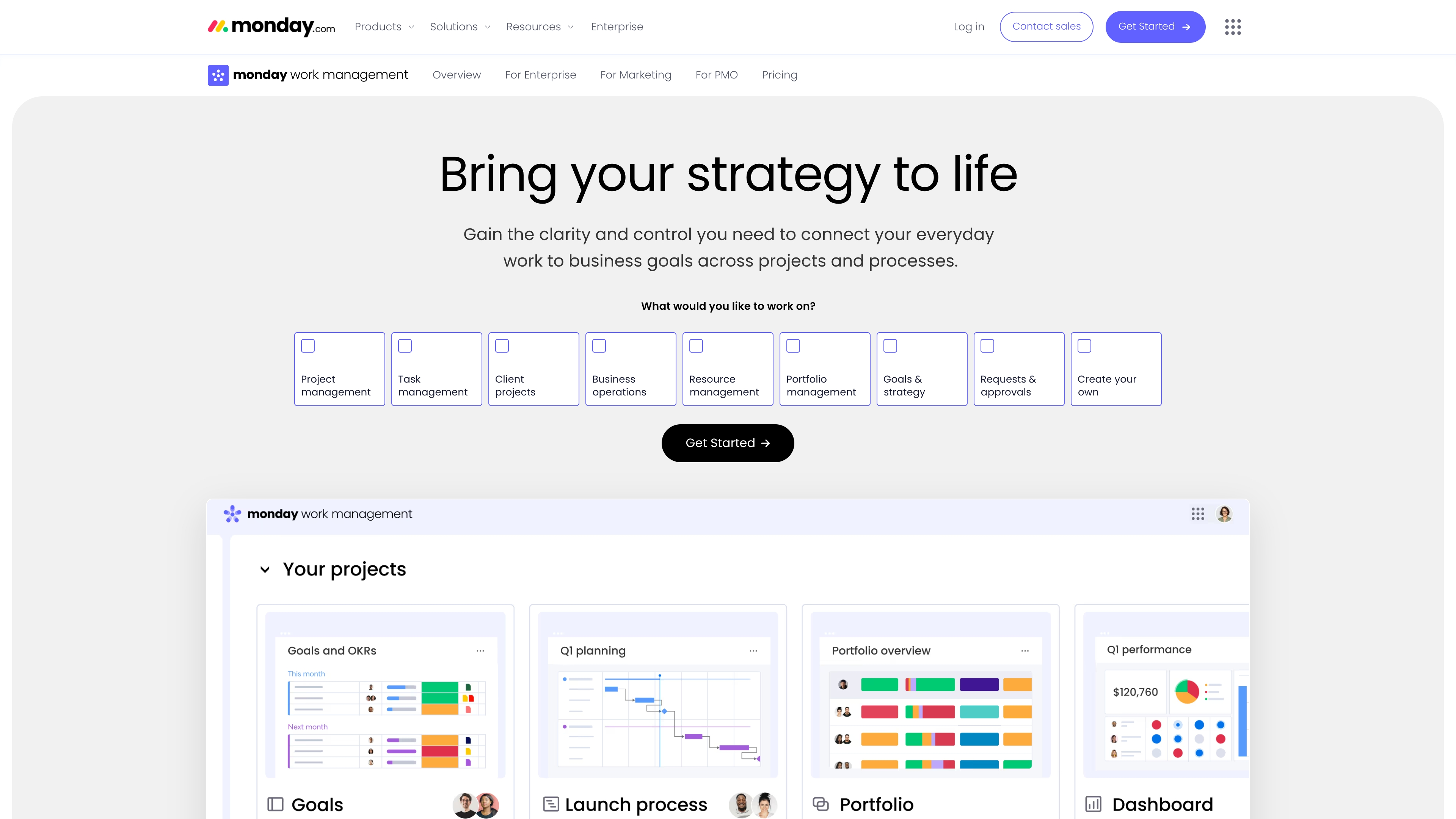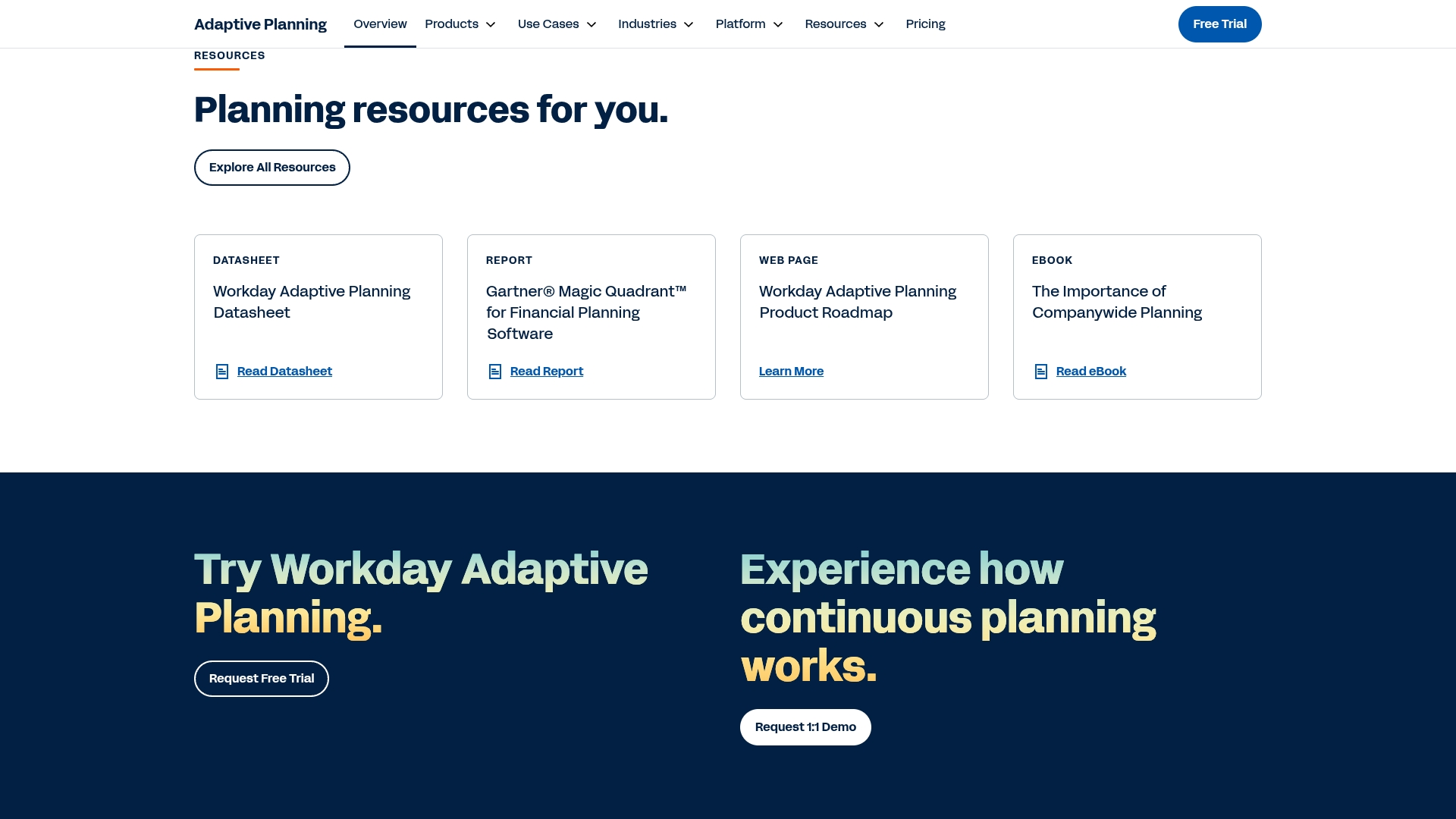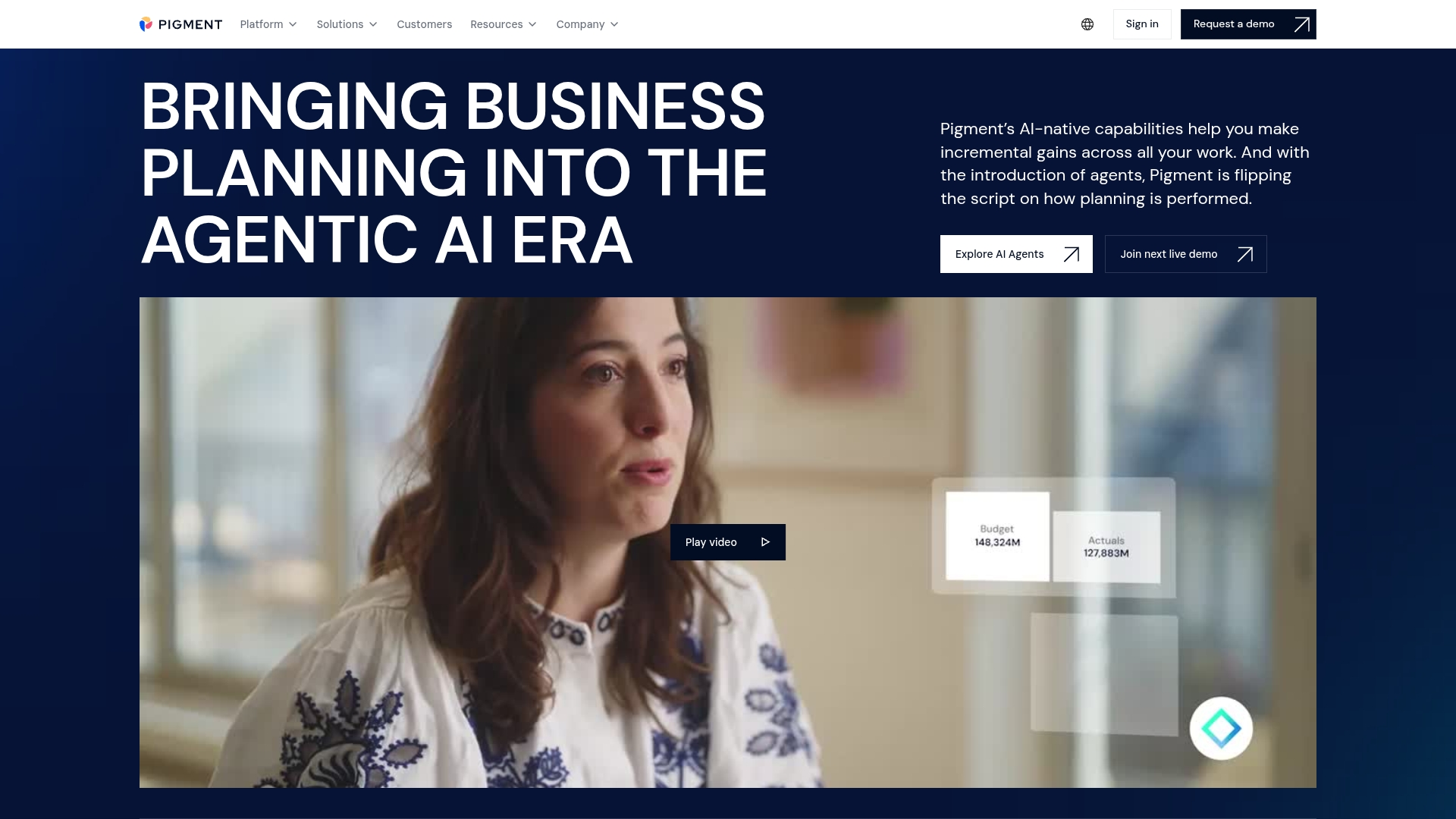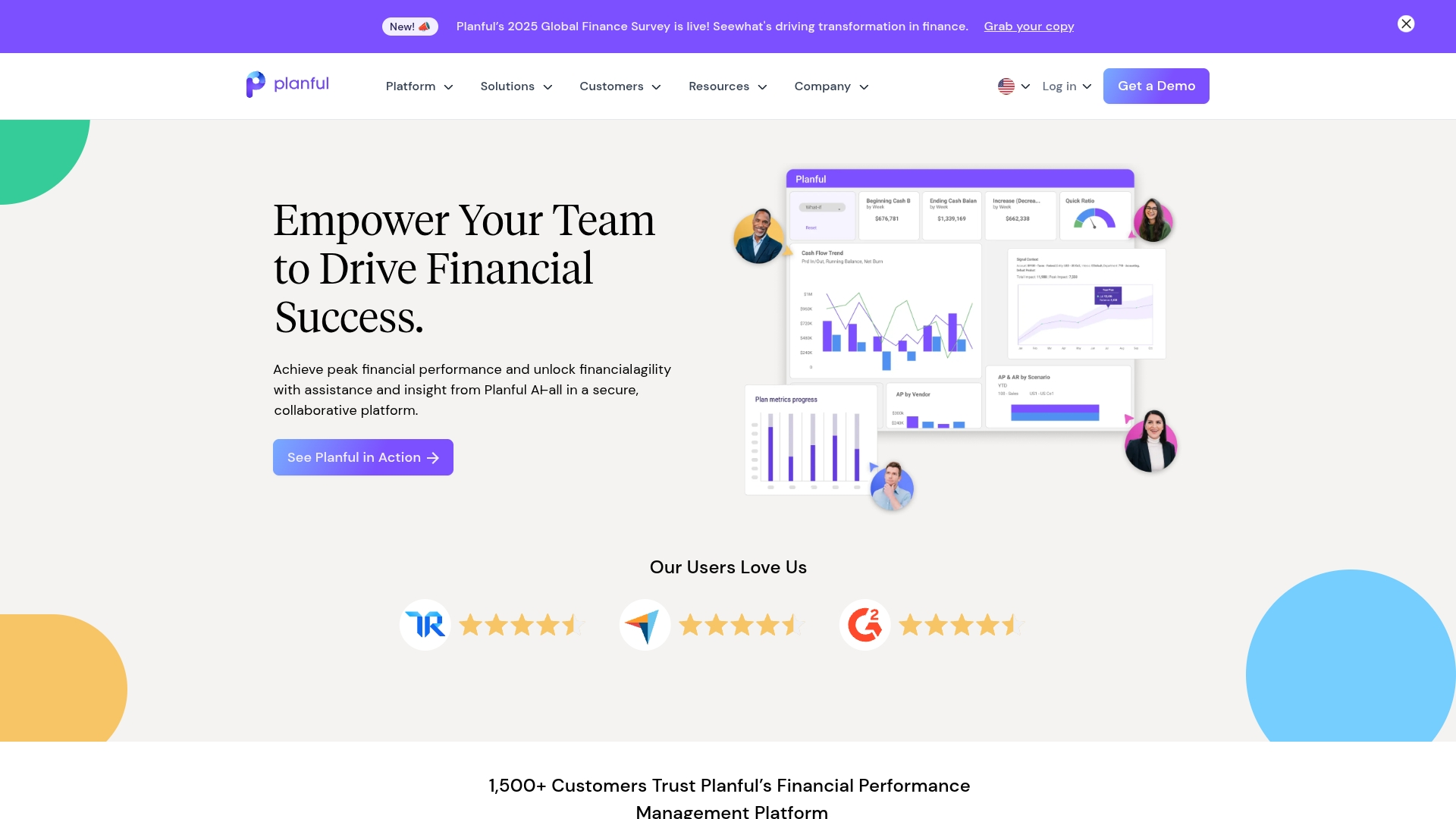When your business strategy is disconnected from the daily grind, you lose the agility to react to market shifts and lose out on valuable opportunities.
This guide explores how the right adaptive planning software transforms rigid forecasts into a dynamic playbook that connects strategy directly to execution. We’ll break down the tools that make this possible, showing how a unified platform like monday work management helps your team call the winning play, every time.
What is adaptive planning software?
Adaptive planning connects high-level strategy directly to the work getting done, so when things inevitably shift, you’re not caught off guard, you’re ready to make the next winning move.
We’re moving past those annual plans that feel obsolete the second they’re approved. Instead of locking in guesses, adaptive planning gives us the power to adjust our course based on what’s actually happening, building momentum with today’s data rather than getting stuck on yesterday’s assumptions.
This is where it all clicks. By bringing everyone onto a unified platform like monday work management, planning stops being a top-down chore and becomes continuous and collaborative.
Why teams need adaptive budgeting software
Adaptive budget planning software lets us look ahead, turning our financial plan from a static document into a dynamic playbook that keeps pace with our business and empowers us to make winning moves.
When we bring our financial planning into a platform like monday work management, we’re building more than a budget; we’re creating a single source of truth for the whole team. This connects every department to the same real-time numbers, so we can stop chasing down data and start making smarter, faster decisions together.
This shift transforms finance from a reactive chore into a proactive strategy. We gain the confidence to pivot, re-allocate resources to chase new opportunities, and keep the entire organization aligned and charging toward the same goals.
Key features of adaptive financial software
Great financial planning isn’t about perfectly predicting the future; it’s about building a team that’s ready for anything. When your financial tools are as flexible as your strategy, you stop just reacting to change and start leading the charge. This is how we turn market shifts from scary unknowns into our next big opportunity.
We’ve all been burned by the dreaded broken spreadsheet. Adaptive software is our way out of that mess, acting less like a fragile calculator and more like a dynamic game plan for our finances. It’s built to help us see the story behind the numbers.
The real magic happens when these tools connect directly to the work being done, creating one seamless flow. Here are the power plays that make it happen.
- AI-driven forecasting gives your team a clear-eyed view of what’s just around the corner. It goes beyond old data to spot hidden trends, giving you forecasts you can actually build a solid plan on. This means fewer surprises and a whole lot more confidence.
- Dynamic scenario modeling lets you play out every “what if?” without the manual madness. Instantly see the financial impact of different decisions, empowering your team to explore bold ideas and prepare for any outcome side-by-side.
- Automated integrations put an end to the copy-paste chaos for good. By connecting your financial platform directly to your other work hubs, you ensure everyone is operating from the same, up-to-the-minute source of truth—no questions asked.
1. monday work management
monday work management turns scattered tasks into clear, trackable workflows—letting teams plan, execute, and adapt in one friendly workspace. While it’s first and foremost a project management platform, it also offers light resource- and budget-tracking tools that help teams keep an eye on costs without jumping into a separate finance app.

Best for: Cross-functional teams that want an all-in-one workspace to connect everyday work, resources, and high-level goals—without needing coding chops.
Key features
- Drag-and-drop, low-code workflows with 200+ templates to fit any process
- AI-powered automations for tasks like data categorization, content generation, and summarization
- 10+ board views—Kanban, Gantt, timeline, calendar, workload, and more
- Portfolio & resource dashboards (30+ widgets) to track progress and capacity in real time
- 200+ native integrations (Slack, Jira, HubSpot, etc.) and robust API for custom connections
Powerful AI features
monday’s AI assistant transforms how teams work by handling the tedious stuff that slows us down. With 500 monthly credits included in all paid plans, the AI can summarize lengthy discussions, generate content for reports, categorize incoming data, and even help draft emails—all within your workflow.

This isn’t just about saving time, it’s about elevating your team’s focus to the strategic decisions that actually move the needle.
Advanced automations
The platform’s automation engine turns hours of manual work into background magic that just happens. Set up triggers that automatically assign tasks when deadlines approach, notify stakeholders when budgets hit certain thresholds, or update status across connected boards when a milestone is complete.

These no-code automations mean your team spends less time on status updates and more time driving results that matter.
200+ integrations
With 200+ native integrations, monday connects seamlessly to the tools your team already loves. Pull customer data from HubSpot, sync calendar events from Google, share updates through Slack, or connect to financial systems—all without leaving your workspace.

The robust API also lets you build custom connections to any specialized tools your organization depends on, creating a truly unified command center for your entire operation.
Pricing
- Free – $0 forever | Up to 2 seats, 3 boards, unlimited docs, 200+ templates, 8 column types
- Basic – $9 / seat / month | Unlimited items & viewers, 5 GB storage, 1-board dashboards
- Standard – $12 / seat / month | Timeline & Gantt views, guest access, 250 automations and integrations/month, 5-board dashboards
- Pro – $19 / seat / month | Private boards, time tracking, formula columns, 25,000 automations and integrations/month, 20-board dashboards
- Enterprise – Custom | Advanced security & governance, 250,000 automations + integrations/month, 50-board dashboards, enterprise-grade support
(All paid tiers include 500 AI credits per account each month.)
Why it stands out
- One place for projects, resources, light budgeting, and reporting — so we ditch tab-hopping.
- No-code building blocks mean anyone can build workflows (goodbye, IT ticket queue).
- AI features tackle repetitive work, freeing the team to focus on strategy and creativity.
In short, monday work management brings projects, people, and data together, helping us spend less time coordinating and more time doing.
2. Workday Adaptive Planning
Workday Adaptive Planning delivers enterprise-grade financial planning and analysis capabilities that unify budgeting, forecasting, and workforce planning software in one intelligent platform.
The solution specializes in connecting financial data with operational insights through AI-powered analytics, making it ideal for mid-sized to large organizations seeking comprehensive enterprise performance management. Originally founded as Adaptive Insights before being acquired by Workday in 2018, it now serves over 7,000 customers globally.

Best for: Organizations requiring integrated financial and operational planning with seamless connectivity to Workday’s broader HCM and financial management ecosystem.
Key features
- Unified financial planning and analysis with workforce and operational planning capabilities
- AI-powered scenario modeling and predictive project management forecasting with anomaly detection
- Elastic Hypercube Technology for rapid processing of complex, multidimensional models
Pricing
- Pricing varies based on package selection and organizational requirements
- Custom quotes required through direct sales contact
- 30-day free trial available
Considerations
- Complex initial setup and configuration often requiring implementation consultants or extensive training
- Performance can slow when handling very large datasets, and pricing is considered high with potentially opaque cost structure
3. Anaplan
Anaplan transforms complex enterprise planning from scattered spreadsheets into a unified, real-time powerhouse. This connected planning platform specializes in breaking down departmental silos, making it the go-to choice for large organizations that need to align finance, operations, sales, and HR planning in one collaborative environment.
Best for: Large enterprises seeking to unify strategic, financial, and operational planning across multiple departments with powerful scenario modeling capabilities.
Key features
- Connected planning that links finance, sales, supply chain, and HR plans in real-time
- Hyperblock® calculation engine for rapid “what-if” scenario modeling and analysis
- Workflow automation with customized approval processes and audit trails
Pricing: Pricing information is not publicly available
Considerations
- High implementation complexity and costs that may require specialized expertise or consulting partners
- Performance can slow with extremely large datasets or high numbers of concurrent users
4. OneStream
OneStream delivers a unified financial management platform that transforms scattered financial processes into streamlined, adaptive workflows. The platform specializes in connecting planning, consolidation, and reporting within a single system, making it ideal for large enterprises managing complex financial operations across multiple divisions.

Best for: Large enterprises seeking to unify their financial close, planning, and reporting processes within a single adaptive platform that eliminates data silos and reduces integration complexity.
Key features
- Task Manager with visual Gantt charts and real-time progress monitoring for financial close processes
- Unified financial data model that connects planning directly to consolidation and reporting
- MarketPlace ecosystem offering downloadable solutions like account reconciliations and people planning
Pricing
- Pricing information not publicly available – contact OneStream for custom enterprise quotes
Considerations
- Primarily designed for large enterprises, making it potentially cost-prohibitive for mid-market companies
- Work management capabilities are specialized for financial processes rather than general project management needs
5. Oracle Fusion Cloud EPM
Oracle Fusion Cloud EPM delivers enterprise-grade adaptive planning software that transforms financial chaos into strategic clarity. The platform specializes in connecting financial planning with operational execution across global organizations, making it ideal for large enterprises managing complex, multi-departmental budgeting and forecasting processes.

Best for: Large enterprises seeking comprehensive adaptive planning systems that integrate financial management with AI-powered forecasting and automated workflow orchestration.
Key features
- End-to-end financial lifecycle management from planning to reporting with seamless integration
- AI-powered forecasting capabilities that improve prediction accuracy and adapt to market changes
- Automated task management and workflow orchestration for complex financial close processes
Pricing
- Contact Oracle sales for customized enterprise pricing
- Pricing varies based on modules, user count, and implementation scope
- Oracle Universal Credits system available for flexible consumption-based billing
Considerations
- Complex implementation process that may require extensive customization and lengthy deployment cycles
- Higher cost structure compared to specialized adaptive budgeting software solutions, particularly for mid-market organizations
6. Pigment
Pigment transforms business planning from spreadsheet chaos into intelligent, collaborative strategy execution. The platform specializes in real-time adaptive planning with AI-powered insights, making it ideal for medium to large enterprises seeking agile financial planning and cross-functional alignment.
With its intuitive interface and powerful modeling engine, Pigment bridges the gap between complex enterprise planning needs and user-friendly design.

Best for: Enterprise teams looking to replace spreadsheet-based planning with a collaborative, AI-enhanced adaptive planning system that connects finance, sales, HR, and operations in real-time.
Key features
- Real-time scenario planning with what-if analysis capabilities for rapid strategic pivots
- AI-powered forecasting and modeling assistance that accelerates planning cycles
- Cross-functional collaboration with automated workflows, comments, and approval processes
Pricing
- Custom enterprise pricing available through sales consultation
- No publicly listed pricing tiers or plans
- Contact sales team for detailed pricing information based on organizational needs
Considerations
- Steep learning curve despite intuitive interface, particularly for users new to advanced planning platforms
- Implementation complexity may require significant setup time and training investment for full adoption
7. Planful
Planful delivers comprehensive financial performance management that transforms scattered spreadsheets into unified, automated planning workflows. The platform specializes in consolidation-first architecture and finance-owned systems, making it ideal for mid-market organizations seeking rapid time-to-value from their adaptive planning software.

Best for: Finance teams who need an Excel-friendly adaptive planning system that combines budgeting, forecasting, and financial close processes in one unified platform.
Key features
- Rolling forecasts with continuous planning adjustments that keep adaptive budget software current with changing business conditions
- Automated report distribution that eliminates manual reporting tasks and ensures consistent information sharing across teams
- Simple workflow approvals with built-in task management that streamlines planning cycles and maintains compliance governance
Pricing: Custom pricing based on your organization’s size and requirements.
Considerations
- Initial implementation can be complex and may require third-party consultants to achieve optimal configuration
- Advanced reporting customization has a steep learning curve despite the platform’s overall user-friendly design
8. IBM Planning Analytics
IBM Planning Analytics transforms complex financial planning into streamlined, AI-powered decision-making for enterprise teams. The platform combines the familiar feel of Excel with the robust power of an in-memory analytics engine, making it perfect for finance teams who need sophisticated modeling without sacrificing usability.
Built on IBM’s proven TM1 technology, it delivers real-time insights that help organizations move from reactive reporting to proactive strategic planning.

Best for: Large enterprises seeking an adaptive planning system that combines Excel familiarity with enterprise-grade analytics and AI-enhanced forecasting capabilities.
Key features
- AI-powered predictive forecasting that improves accuracy without requiring data science expertise
- Multidimensional modeling engine that processes millions of rows per second for real-time scenario analysis
- Deep Excel integration through Planning Analytics for Excel (PAfE) that maintains familiar workflows while adding database control
Pricing
- Pricing information not publicly available
- Contact IBM sales for custom enterprise quotes
- SaaS model priced per user
Considerations
- Complex interface that may require significant training for new users compared to cloud-native adaptive planning software alternatives
- Visualization capabilities could be stronger, with some users noting limitations in the self-service interface for advanced customization needs
Use monday work management for your adaptive planning
When planning is collaborative and connected to execution, we swap guesswork for genuine confidence. We can see what’s working, adjust our course on the fly, and make smarter decisions together without getting bogged down in endless meetings or messy spreadsheets. It’s all about building momentum and keeping it.
monday work management is the platform where this all comes together, uniting our plans and our work in one clear, visual space. It’s how we transform scattered efforts into streamlined execution, giving every team member the clarity they need to move forward, faster. Ready to build plans that move with you? Get Started.
FAQs
How does adaptive planning differ from legacy planning tools?
Adaptive planning offers continuous, collaborative planning with real-time data, while legacy tools rely on static spreadsheets that quickly become outdated. This flexibility means your team can adjust to change instantly, keeping everyone aligned and moving forward.
Does adaptive budgeting software integrate with CRM or HR systems?
Yes, it integrates with core systems like CRM and HR to pull in live revenue and workforce data for a complete financial picture. This connection ensures your budget always reflects actual business activity.
What is adaptive FP&A when compared to EPM?
Adaptive FP&A focuses specifically on financial forecasting and analysis, while EPM is a broader category that also includes operational and strategic performance. Think of FP&A as the financial engine within the larger EPM framework.
Is there a recommended path to implement adaptive software across a global workforce?
Absolutely—start with a pilot program in one department to build momentum and create internal champions before a wider rollout. This phased approach minimizes risk and sets your teams up for a successful transition.
Which adaptive analytics functions are most relevant for operational teams?
Operational teams get the most value from real-time performance dashboards, resource allocation tools, and variance analysis. These functions help them spot bottlenecks and adjust plans to keep work on track.
How can companies transition from spreadsheets to adaptive planning tools?
Use a phased approach that includes migrating key data and providing hands-on team training to build confidence. The goal isn’t just to digitize old spreadsheets, but to transform your processes with powerful automation and collaboration.
 Get started
Get started 

